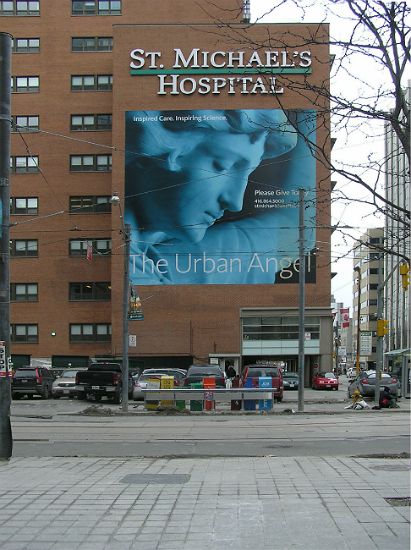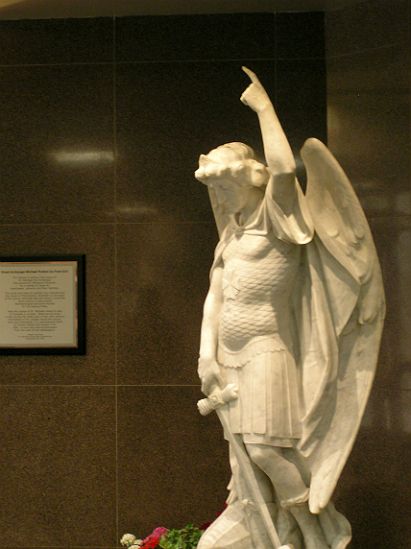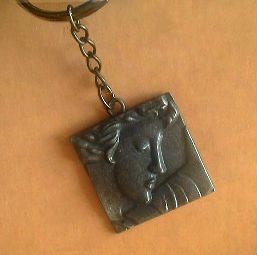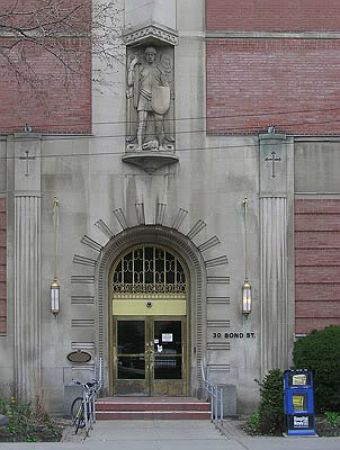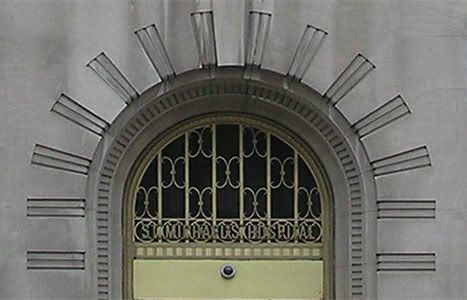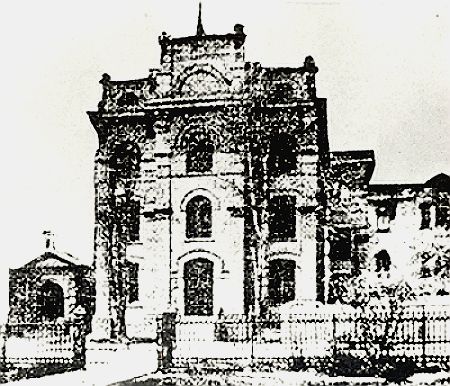
I first came upon West 44th street between 5th and 6th Avenues in 2009 when I went to New York and Princeton to participate in my first anti-Jihad event. I met the (now dormant) International Free Press Society's Bjorn Larsen outside the Harvard Club, where there was a private luncheon for Muhammad Cartoonist Kurt Westergaard. A small group of us, including Bjorn, Lars Hedegaard (who was at one time after this event confined to his house in his native Holland to protect him from Muslim antagonists for his negative commentary on Muslim immigrants), Paul Belien of the Brussels Journal, and Westergaard traveled to Princeton University for a presentations by Westergaard, and later that evening, to attend a private reception for Westergaard at a mid-town New York apartment. The day after the event in Princeton, I met Larry Auster for the first time, at The Red Flame Diner in New York on 44th Street. I had been communicating with Larry for a few years as a commentator on his website The View From the Right.
Below is an interesting article about this one-block strip, with its various intellectual and literary clubs. One is the Alogonquin Hotel, where the infamous Round Table met. I went inside the restaurant on another trip, to see the menu, and realized that I could afford one item (say the shrimp cocktail for $20). I also mentioned the prestigious Harvard Club after visit in that block in 2012.
It is amazing that so much happened (and happens) in such a tiny, hidden, part of New York.

Waiting on The Algonquin
[Photo By: KPA]
Positively 44th Street
By: Alex Shoumatoff
Vanity Fair
June 12, 2014
Room 2806, the presidential suite in the Sofitel at 45 West 44th Street, goes for $3,000 a night, which is not out of line for a suite in Midtown Manhattan. The Mandarin Oriental on Columbus Circle has one for $18,000. But three grand is a lot more than the seedy Hotel Seymour, which occupied the Sofitel site until being demolished in 1983, used to charge for a room. The Seymour was one of the three welfare or S.R.O. (single-room occupancy) hotels, as they were also called, on the block—44th between Fifth and Sixth—where retired theater people had been living for years at reduced rates. In the 70s, I remember, I met one Broadway widow—a heavily rouged woman in her 80s who smoked cigarettes through a long black holder and called me “Dahling,” à la Tallulah Bankhead—at the Teheran, the bar down the block from the Seymour that everybody went to after work; it, too, is gone. The two other residential hotels were the Royalton, at 44 West 44th, and the Mansfield, at 12 West 44th, which were both renovated in the late 80s and 90s when the Times Square district was “Disneyfied,” as critics called the process. They are both now boutique hotels, though not as luxurious or pricey as the haute Euro Sofitel.
The Royalton was resurrected in 1988 by the hotelier Ian Schrager. In 1992 he brought in the downtown restaurateur Brian McNally, who had opened a string of hot spots the previous decade, including Indochine, the Odeon, and Canal Bar, to run its restaurant. McNally made the restaurant—called Forty Four—and the Royalton’s Philippe Starck-designed lobby the place to eat and meet and be seen, particularly for the literati, as the Algonquin Hotel across the street had been 60 years before, when the roués of the Round Table had their famous drunken luncheons there.
On May 14 of last year, between 12:07 and 12:13 p.m., Room 2806 in the Sofitel acquired a place in the annals of tawdriness and in the rich social history of the block, when Dominique Strauss-Kahn, the managing director of the International Monetary Fund, who was leading the polls for France’s forthcoming presidential election, had a hurried sexual encounter with the Guinean housemaid Nafissatou Diallo as he was preparing to vacate the suite. The circumstances—whether it was consensual or an assault—are disputed, but after Strauss-Kahn was taken off a plane to Paris later that day and imprisoned on Rikers Island on charges that were later dropped because of issues with Ms. Diallo’s credibility, a female journalist in France came forth with a similar account of having been attacked by D.S.K. eight years earlier. His career at the I.M.F. and his French presidential aspirations were finished.
If anyone on the block was scandalized by this bit of Euro-loucheness, it would have been farther down toward Fifth Avenue, in the stately neo-Georgian Harvard Club, at 35 West 44th, and next door in the beguiling Beaux Arts New York Yacht Club, at 37, whose windows look like they were plucked from a galleon. But it would be a bit of a stretch for these bastions of the old East Coast Wasp imperium, or what is left of it, to feel like their escutcheons had been besmirched. They probably don’t bear much scrutiny themselves these days, the noblesse oblige and ethos of service and stewardship of the old blueblood ruling class having been hemorrhaging since the presidency of Nixon and being, at this point, pretty much gone. Plus, this block has seen it all. The illicit trysts that have taken place on it would be impossible to chronicle. Back in the 20s, the playwright George Kaufman, who was a member of the Round Table and one of the progenitors of situation comedy, ran into an old flame in the elevator of the Algonquin Hotel, on the arm of a new beau, whom she introduced as being “in cotton,” and he came out with a memorable one-liner: “And them that plants ’em is soon forgotten.”

Inside the Algonquin, 1986
By Peter Freed/The New York Times
(From the online slideshow on Vanity Fair's June 2012 article Positively 44th Street)
Many completely different worlds, many different cultures, networks, and scenes coexist on this one block of West 44th Street. You could spend your life trying to find out what happened and what is happening along this 250-yard stretch of pavement and not begin to scratch the surface. Its baseline component is the local Midtown culture, which is New York melting pot flavored with the flimflam of Tin Pan Alley and Times Square, both within spitting distance. In fact, the Hippodrome, the largest and most successful theater in New York in the first part of the 20th century, was right on the southeast corner of 44th and Sixth Avenue. Before that it was a carriage house and stable for the trotting horses of wealthy sportsmen of the Vanderbilt-Rockefeller set. Houdini made a five-ton elephant disappear before a crowd of more than 5,000 at the Hippodrome. The site today is occupied by a nondescript glass office tower.
But the indigenous Midtown culture is still alive and well, I was glad to find, in the arcade of the old New Yorker building, which runs from 28 West 44th Street to 25 West 43rd Street. From 1935 until 1991, The New Yorker magazine had its “Dickensian” offices, as they were invariably called, on the 18th, 19th, and 20th floors of this building (which was then known as the National Association Building). I had one of them when I was a staff writer at the magazine, from 1978 to 1990. It was tiny and spartan, with just enough room for a table and a chair, a bookshelf, and an ancient black Royal typewriter probably used by its previous tenant, a revered “fact” editor and reporter named St. Clair McKelway, whose demise had made it available. (A tall man who mumbled in his mustache and was given to bouts of paranoia, McKelway, who served as a public-relations officer for the military on Guam in 1944, is most remembered for firing off a telegram to the Pentagon accusing Admiral Chester Nimitz, the commander of the Pacific Fleet in World War II, of high treason.) “Fact” was the quirky New Yorker term for journalism, as opposed to fiction. It avoided being defined by what it wasn’t: nonfiction.
The arcade of the National Association Building was like a little self-contained global village where your basic necessities were taken care of. There was a barber, a tailor, a coffee shop, a newsstand, a watch-repair shop, even a post office. To me this arcade is the very omphalos—the navel—of Gotham. The guy at the Arcade Hair Styling Salon for Men and Women who cut my hair 30 years ago is still there, I noticed when I was passing through at the beginning of last December. His name is Aldo Nestico and he’s 67 now. Half a dozen old-timers, longtime customers from the neighborhood, were sitting in the salon’s waiting section in Miami Beach leisure suits. One of them was wearing a loud plaid golf cap. None of them looked like they particularly needed a haircut. But I did, my last cut being a three-dollar job in Borneo three months earlier. I booked a cut with Aldo for the following afternoon.
Aldo came over from Calabria in 1955 on the Andrea Doria, a year before it went down, “or I wouldn’t be here,” as he points out. He has cut a lot of famous people’s hair, including the Beatles’. But the guy with the stories, with the gift of gab, is snipping away at the next chair—Andreas Pavlou, who has been cutting hair in the neighborhood since 1964 and is originally from Cyprus. Having a captive audience who is all ears, he uncorks the following classic New York yarn.
‘It was around this time of year many years ago, a few weeks before Christmas. I am finishing a haircut at the shop across the street and suddenly the guy starts sweating and it’s cold outside and I says to him, ‘You don’t look so good. Maybe we should call an ambulance,’ and he says, ‘I’m O.K. I’m just coming down with a cold. I’m going to go home and kill my wife for giving me this virus.’ But when he gets up he starts staggering and asks if he can sit on the couch for a minute, and while he is lying there on his side he has a heart attack. I call an ambulance and by the time it arrives the guy is dead. The paramedic gives him CPR, but it’s no use. It’s 11 in the morning and everybody is starting to come. The paramedic says, ‘I have to leave him here so the police can come and make sure you didn’t do it.’ I says, ‘You can’t do that. It’ll be the end of my business.’ So we sit him up on the couch and cross his legs and put a New York Times in his hands and spread it out so nobody can see he’s dead. All day long customers come and sit right next to him and nobody notices. At five o’clock a huge guy comes and sits on the couch, and the corpse slumps over onto him, and I says to the corpse, ‘Look, if you want to take a nap, why don’t you get a hotel room,’ and I prop him back up and everything is still fine. Finally at 7:30 the cops come and one of them asks, ‘O.K., where’s the stiff?,’ and I says, ‘Over there on the couch,’ and he asks, ‘Well, did he pay you?,’ and I says ‘No,’ and the cop shakes his head and says, ‘The things people will do to get out of paying. But this is a new one,’ and I says to him, ‘Well, there’s a first time for everything.’ ”

The New York Yacht Club
Photograph By: Jonathan Becker
(From the online slideshow on Vanity Fair's June 2012 article Positively 44th Street)
Posted By: Kidist P. Asrat





































